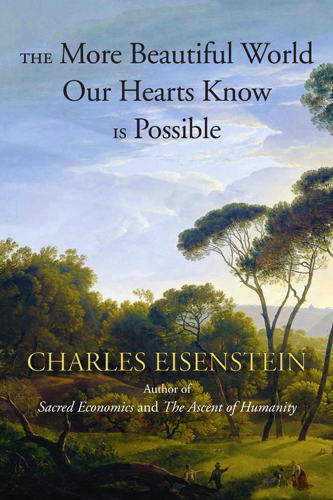Climate — A New Story
Chapters
Chapter 6: A Bargain with the Devil
Rights of Nature
The revolution is love. It isn’t about more cleverly valuing and utilizing nature. It is about genuine respect for nature, which can come only by seeing it as a being in all fullness, and holding it sacred. Where is the sacredness when we have reduced it to a finite value? We need a better reason to care for the world, a truer reason. We need to connect with a source of motivation that isn’t even reasonable.
In writing this book, I was tempted (and advised) to avoid saying things like “The earth is alive and sentient.” Such statements exclude me from consideration by policymakers, who need arguments framed in rational terms. But can we ever reason our way to love? “Rational” in this context is usually a code for utilitarianism. Since when is love rational? The truth is, we love the earth for what it is, not merely for what it provides.
I suspect that even the most hardheaded environmentalist, who derides the Earth-is-alive crowd most vociferously, harbors a secret longing for the very object of his contempt. Deep down, he too believes the planet and everything on it is alive and sacred. He is afraid to touch that knowledge even as he longs for it.
This person is also me. The idea of a living, sentient Earth attracts me and repels me both, mirroring the polarity of opinion I observe at conferences between the nuts-and-bolts and spiritual factions. Accusations of “naive!” “softheaded!” and “unscientific” rattle around in my own brain, expressing a hurting thing within. Maybe if I join the ranks of the critics and turn the criticism outward, accuse others of ignoring science and indulging in fuzzy thinking, I can find some temporary relief. But it would be more honest of me to embrace my irrationality. And it might be more inspiring to others too, to invoke in them the same biophilia I know within myself.
The idea that our planet is alive, and further, that every mountain, river, lake, and forest is a living being, even a sentient, purposive, sacred being, is not a soppy emotional distraction from the environmental problems at hand; to the contrary, it disposes us to feel more, to care more, and to do more. No longer can we hide from our grief and love behind the ideology that the world is just a pile of stuff to be used instrumentally for our own ends.
Given how central instrumental utilitarianism is to the world-destroying machine, the environmental movement must take care not to reinforce that story with its rhetoric. It must inhabit, enact, and propagate a different story: of care, of beauty, and of love. This does not mean that it should ignore the consequences of ecocide for human beings—after all, we are also among Gaia’s beloveds—but that it should avoid elevating those arguments to primary status. Yet this is the language, nearly the exclusive language, of “serious” policy conversations about climate and other environmental issues. It hasn’t been working. Maybe we should try once again the language of love.
By denying the nonhuman material world the qualities of a lovable self, we make nature and the material world unlovable. If at bottom the world is composed of a bunch of generic, purposeless particles governed by impersonal, random forces, what is there to love? Locutions such as “natural resources” and even “the environment” foster this kind of ideological separation. Compassionate love comes from the realization that you are a self, just like I am. A child looks up at the sun and knows it looks back at her. Then we grow up and know better; we dismiss those perceptions as a childish anthropomorphic projection; the scientist does the same when he or she claims that only humans possess the full degree of consciousness, agency, intention, desire, and experience of being; that animals possess these things, perhaps, to a lesser degree—the “lower” the animal (i.e., the more unlike ourselves) the less; that plants possess only a rudimentary amount of them if at all; and that these qualities of a self are surely absent from rivers, mountains, soil, water, and rocks. But intuitively, we, like the child, like older cultures, know better. We know that the whole world that environs us is a self in all fullness, and so is every part of it.
While money is insufficient to reflect the value of that which is beyond price, we do have another instrument of human agreement to apply here: law. The growing Rights of Nature movement seeks to secure legal status for nonhuman beings; so far, Bolivia, Ecuador, and New Zealand have written these rights into law. The earth rights lawyer Polly Higgins has campaigned to extend them globally by adding ecocide to the list of crimes against peace alongside genocide, war crimes, crimes of aggression, and crimes against humanity, putting it under the jurisdiction of the International Criminal Court. This would elevate interbeing to something more than a personal philosophy or religious orientation. It would enshrine it as a foundational principle of a different kind of society.[9]
Once upon a time, science saw notions like the personhood of nature ridiculous. Although the science is changing (for example, a growing contingent of biologists is seriously considering the possibility of plant intelligence), to this day many would feel vulnerable to accusations of fuzzy-headedness if we said, “Who cares about the costs and benefits. Let’s save this forest just because we love it. Let’s save it because it is just so beautiful.”
That is not to say we should never cut down trees. It is to say that such an act should not be facilitated by an ideology that holds trees—and all life—as anything other than sacred. When we see the forests in terms of board feet or timber value, when we see the oceans in terms of tons of protein or dollars’ worth of fish catch, when we speak of nations as “economies” and people as “consumers”; when we see a place as a source of iron ore or bauxite or gold, when we see these minerals as nothing but minerals, randomly deposited and unrelated to the processes of life around them, when we see a forest or peat bog in terms of its carbon sequestration potential, then we are seeing Earth as a machine, not an organism, dead and not alive.
The reason our current system of material production kills the world is that it starts by seeing the world as dead. What then is there to love?
End Notes
[9] “Rights of Nature” may not be the best term to confer legal personhood onto beings of nature, since the notion of rights takes as elementary the individual and the state. For indigenous and other community-based cultures, “rights” is not a coherent concept. We might be cautious about extending the notion to the nonhuman world. An alternative might be “responsibility to nature.” The important thing is to somehow encode nonhuman personhood into the framework of agreements and narratives that we call law.






